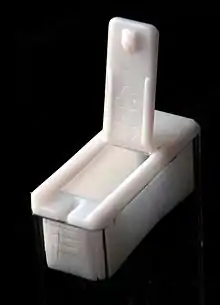Living hinge
A living hinge is a thin flexible hinge (flexure bearing) made from the same material as the two rigid pieces it connects. It is typically thinned or cut to allow the rigid pieces to bend along the line of the hinge. The minimal friction and very little wear in such a hinge makes it useful in the design of microelectromechanical systems, and the low cost and ease of manufacturing makes them quite common in disposable, recyclable packaging.[1]

Plastic
Plastic living hinges are typically manufactured in an injection molding operation that creates all three parts at one time as a single piece, and if correctly designed and constructed, it can remain functional over the life of the part. Polyethylene and polypropylene are considered to be the best resins for living hinges, due to their excellent fatigue resistance.[2][3]
Wood
.jpg.webp)
A variant on the kerf bend can be used to create living hinges in laser cut wood. The technique is popular for making light-duty hinges with large radii.[4] It is also possible to create a living wood joint by hand, but the result is less accurate.[5]
See also
References
- "Engineering Fundamentals: Living Hinge".
- Proto Labs 2014-12 Design Tips
- Dominic Muren (2005-08-15). "Hinges, both living and dead".
- Sean Michael Ragan (2011-10-25). "Plywood Living Hinge Design for Laser Cutters".
- https://www.youtube.com/watch?v=gYwtYbFfG0E
External links
| Wikimedia Commons has media related to Living hinges. |
- RTP Company – engineering specifications for a living hinge
- Boxdesigner – The box above was original created with this webservice